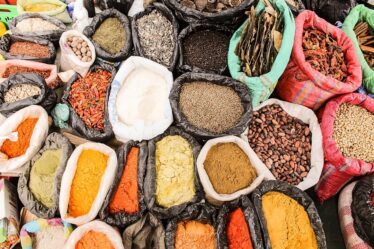
Indian cuisine is known for its bold and vibrant flavors, and at the heart of these flavors are the aromatic and flavorful spices that are used in abundance. Indian spices are a diverse and integral part of the country’s culinary heritage, with each spice adding its own unique taste and aroma to dishes. From the fiery heat of chili peppers to the warm sweetness of cinnamon, Indian spices are what make Indian food so delicious and memorable.
Spices play a crucial role in Indian cuisine, not only for their taste but also for their medicinal properties. They are used in various forms – whole, ground, roasted, or as spice blends – to enhance the flavor and aroma of dishes. Whether it’s a simple dal or a complex biryani, spices are what give Indian food its distinct character.
Key Takeaways
- Indian spices are known for their aromatic and flavorful qualities.
- The history of Indian spices dates back to ancient times and continues to be an important part of modern-day cuisine.
- Indian spices offer a range of health benefits and can be used as a natural medicine cabinet.
- The art of spice blending is a key aspect of Indian cuisine and secrets are passed down through generations.
- The top 10 Indian spices you need in your kitchen include cumin, coriander, turmeric, cardamom, and cinnamon.
- Regional varieties of Indian spices offer a culinary tour of the country’s diverse cuisine.
- Vegetarian Indian spices offer a feast for the senses with a range of flavors and textures.
- Indian spices are commonly used in popular dishes such as curry and biryani.
- Cooking with Indian spices requires some tips and tricks for perfect results.
- Pairing Indian spices with wine and beer can enhance complementary flavors and create a unique dining experience.
The History of Indian Spices: From Ancient Times to Modern Day
The use of spices in Indian cuisine dates back thousands of years. Spices have always held a special place in Indian culture, not just for their culinary value but also for their medicinal properties. In ancient times, spices were considered precious commodities and were even used as currency. They were highly sought after by traders from around the world, leading to the establishment of the spice trade routes.
The spice trade had a profound impact on Indian cuisine. It introduced new flavors and ingredients to the country, which were then incorporated into local dishes. The trade routes also brought cultural exchange, as traders from different regions brought their own spices and cooking techniques. This led to the evolution of Indian spices and the development of regional variations in flavor profiles.
In modern times, Indian spices continue to be an integral part of the country’s culinary landscape. They are not only used in traditional dishes but also in fusion cuisines that combine Indian flavors with other global cuisines. The popularity of Indian food has spread worldwide, with people from different cultures embracing the rich and diverse flavors of Indian spices.
The Health Benefits of Indian Spices: A Natural Medicine Cabinet
Indian spices are not just known for their taste, but also for their numerous health benefits. Many Indian spices have medicinal properties and have been used in Ayurvedic medicine for centuries. These spices are believed to have healing properties and can help improve digestion, boost immunity, reduce inflammation, and more.
Turmeric, for example, is a spice that is widely used in Indian cooking and is known for its anti-inflammatory properties. It contains a compound called curcumin, which has been shown to have antioxidant and anti-inflammatory effects. Ginger is another spice that is commonly used in Indian cuisine and is known for its digestive benefits. It can help relieve nausea, reduce inflammation, and improve digestion.
Indian spices are also rich in antioxidants, which can help protect the body against oxidative stress and reduce the risk of chronic diseases. Cinnamon, cloves, and cardamom are all spices that are high in antioxidants and can provide numerous health benefits.
The Art of Spice Blending: Secrets of Indian Cuisine
| Recipe Name | Ingredients | Preparation Time | Serving Size |
|---|---|---|---|
| Chicken Tikka Masala | Chicken, Yogurt, Tomatoes, Onions, Garlic, Ginger, Garam Masala, Cumin, Coriander, Paprika, Turmeric, Salt, Pepper | 1 hour | 4 servings |
| Chana Masala | Chickpeas, Tomatoes, Onions, Garlic, Ginger, Garam Masala, Cumin, Coriander, Turmeric, Salt, Pepper | 45 minutes | 4 servings |
| Palak Paneer | Spinach, Paneer, Tomatoes, Onions, Garlic, Ginger, Garam Masala, Cumin, Coriander, Turmeric, Salt, Pepper | 1 hour | 4 servings |
| Naan Bread | Flour, Yeast, Sugar, Salt, Yogurt, Milk, Butter | 2 hours | 8 servings |
One of the secrets to the rich and complex flavors of Indian cuisine lies in the art of spice blending. Indian cooking often involves the use of spice blends, which are carefully crafted combinations of different spices. These blends add depth and complexity to dishes, creating a harmonious balance of flavors.
There are several common spice blends used in Indian cuisine. Garam masala is perhaps the most well-known spice blend, made from a combination of spices such as cinnamon, cardamom, cloves, cumin, coriander, and black pepper. This blend is often added towards the end of cooking to enhance the flavor of dishes.
Another popular spice blend is curry powder, which is a combination of various spices such as turmeric, cumin, coriander, fenugreek, and chili powder. This blend is used as a base for many Indian curries and adds a rich and aromatic flavor to the dish.
Creating your own spice blends at home can be a fun and rewarding experience. By experimenting with different combinations of spices, you can tailor the flavors to your own preferences. It’s important to use high-quality spices and toasting them before grinding to release their full flavor.
The Top 10 Indian Spices You Need in Your Kitchen
If you’re new to Indian cooking or looking to expand your spice collection, there are a few essential Indian spices that you should have in your kitchen. These spices are versatile and can be used in a wide range of dishes, from curries to desserts.
1. Turmeric: Known for its vibrant yellow color and earthy flavor, turmeric is a staple in Indian cooking. It adds a warm and slightly bitter taste to dishes and is also known for its health benefits.
2. Cumin: Cumin seeds have a warm and nutty flavor and are commonly used in Indian dishes. They can be used whole or ground and add a distinct aroma to curries, rice dishes, and lentils.
3. Coriander: Coriander seeds have a citrusy and slightly sweet flavor. They are often used in combination with cumin seeds and add a fresh and aromatic taste to dishes.
4. Cardamom: Cardamom pods contain small black seeds that have a sweet and floral flavor. They are commonly used in desserts, teas, and spice blends like garam masala.
5. Cloves: Cloves have a strong and pungent flavor with hints of sweetness. They are often used in savory dishes like biryanis and curries, as well as in desserts.
6. Cinnamon: Cinnamon sticks have a warm and sweet flavor that adds depth to both sweet and savory dishes. They are commonly used in rice dishes, curries, and desserts.
7. Chili Powder: Chili powder adds heat and spice to dishes. It can be used in moderation for a mild kick or in larger quantities for a fiery flavor.
8. Mustard Seeds: Mustard seeds have a nutty and slightly bitter flavor. They are often used in tempering, where they are fried in oil or ghee to release their flavor.
9. Fenugreek: Fenugreek seeds have a slightly bitter and nutty flavor. They are commonly used in spice blends and add a distinct taste to curries and lentil dishes.
10. Asafoetida: Asafoetida is a pungent spice that is used in small quantities to add depth and umami flavor to dishes. It is often used in lentil dishes and pickles.
These spices can be found at Indian grocery stores or online retailers that specialize in Indian ingredients. It’s important to buy high-quality spices to ensure the best flavor and aroma.
The Regional Varieties of Indian Spices: A Culinary Tour

India is a vast country with diverse regional cuisines, each with its own unique flavors and spice profiles. The spices used in different regions of India vary based on the local climate, geography, and cultural influences.
In the north of India, spices like cumin, coriander, cardamom, cinnamon, and cloves are commonly used. These spices add warmth and depth to dishes like biryanis, kebabs, and creamy curries.
In the south of India, spices like mustard seeds, curry leaves, fenugreek seeds, and black pepper are more prevalent. These spices add a distinct flavor to dishes like dosas, idlis, and coconut-based curries.
In the east of India, spices like mustard seeds, nigella seeds, fennel seeds, and panch phoron (a blend of five spices) are commonly used. These spices add a unique flavor to dishes like fish curries, vegetable stir-fries, and sweets.
In the west of India, spices like turmeric, chili powder, cumin, coriander, and garam masala are widely used. These spices add a bold and robust flavor to dishes like dhokla, pav bhaji, and spicy curries.
Incorporating regional spices into your cooking can help you explore the diverse flavors of Indian cuisine. It’s a great way to add variety to your meals and discover new taste sensations.
Vegetarian Indian Spices: A Feast for the Senses
Indian cuisine is known for its wide variety of vegetarian dishes, and spices play a crucial role in enhancing the flavors of these dishes. Vegetarian Indian food is a feast for the senses, with spices adding depth, aroma, and complexity to the dishes.
Spices like cumin, coriander, turmeric, and chili powder are commonly used in vegetarian curries and stir-fries. These spices add warmth and depth to the dishes, making them satisfying and flavorful.
Ginger and garlic are also commonly used in vegetarian cooking. They add a pungent and aromatic flavor to dishes and help enhance the taste of vegetables and legumes.
Spices like cardamom, cinnamon, cloves, and nutmeg are often used in vegetarian desserts. They add a sweet and aromatic flavor to sweets like kheer (rice pudding) and gulab jamun (deep-fried milk dumplings soaked in sugar syrup).
Vegetarian Indian cuisine is not only delicious but also nutritious. The use of spices adds not only flavor but also health benefits to these dishes. Many Indian spices have antioxidant and anti-inflammatory properties, which can help boost immunity and improve overall health.
Indian Spices in Popular Dishes: Curry, Biryani, and More
Indian cuisine is known for its iconic dishes like curry, biryani, and masala dosa. These dishes are a testament to the rich and diverse flavors of Indian spices.
Curry is perhaps the most well-known Indian dish, and it comes in many variations. The base of a curry is often made with a combination of onions, garlic, ginger, and tomatoes, which are then flavored with a blend of spices like turmeric, cumin, coriander, and garam masala. The choice of spices can vary depending on the region and the type of curry being made.
Biryani is a fragrant rice dish that is often made with basmati rice, meat or vegetables, and a blend of spices. The spices used in biryani can include cinnamon, cardamom, cloves, cumin, coriander, and bay leaves. These spices add depth and complexity to the dish, making it a flavorful and aromatic meal.
Masala dosa is a popular South Indian dish that consists of a crispy rice and lentil crepe filled with a spiced potato filling. The filling is made with mustard seeds, cumin seeds, curry leaves, turmeric, and chili powder. These spices add a burst of flavor to the dish and complement the mildness of the potatoes.
These dishes are just a few examples of the many delicious dishes that can be made with Indian spices. The possibilities are endless, and experimenting with different spices can lead to exciting new flavor combinations.
Cooking with Indian Spices: Tips and Tricks for Perfect Results
Cooking with Indian spices can be intimidating for beginners, but with a few tips and tricks, you can achieve perfect results every time.
Firstly, it’s important to store your spices properly to maintain their freshness and flavor. Whole spices should be stored in airtight containers in a cool and dark place. Ground spices should be stored in small quantities and used within a few months for the best flavor.
Toasting whole spices before grinding or using them in a dish can help enhance their flavor. Simply heat a dry skillet over medium heat and add the spices. Toast them for a few minutes until they become fragrant, being careful not to burn them. Once toasted, you can grind them using a mortar and pestle or a spice grinder.
When cooking with whole spices, it’s important to temper them properly to release their flavors. Tempering involves heating oil or ghee in a pan and adding whole spices like cumin seeds, mustard seeds, or curry leaves. The spices are fried until they become fragrant and then added to the dish.
When using ground spices, it’s important to add them at the right time in the cooking process. Some spices, like turmeric and chili powder, are added at the beginning of cooking to infuse their flavors into the dish. Other spices, like garam masala, are added towards the end of cooking to preserve their aroma.
It’s also important to taste and adjust the seasoning as you cook. Indian cuisine is all about balance, and the right amount of spices can make all the difference in a dish. Start with small amounts of spices and gradually add more until you achieve the desired flavor.
Pairing Indian Spices with Wine and Beer: A Guide to Complementary Flavors
Pairing Indian spices with wine and beer can be a challenge due to the bold and complex flavors of Indian cuisine. However, with some knowledge of complementary flavors, you can create harmonious pairings that enhance both the food and drink.
When it comes to wine, it’s best to choose wines that have enough acidity and fruitiness to balance out the spicy flavors of Indian food. White wines like Riesling, Gewürztraminer, and Sauvignon Blanc are good choices as they have a crisp acidity and fruity flavors that can complement the spices.
For red wines, look for ones that are medium-bodied with soft tannins. Wines like Pinot Noir, Grenache, and Syrah can work well with Indian dishes, as they have enough fruitiness to balance out the spices without overpowering the flavors.
When it comes to beer, opt for ones that have a good balance of maltiness and hoppiness. Indian Pale Ales (IPAs) can work well with spicy Indian dishes, as the hop bitterness can help cut through the heat. Wheat beers and lagers can also be good choices, as they have a lighter and more refreshing flavor that can complement the spices.
When pairing Indian spices with wine or beer, it’s important to consider the intensity of the flavors. If you’re serving a dish with mild spices, you can opt for a lighter wine or beer. For dishes with bold and spicy flavors, go for wines or beers that have more intensity to match the flavors.
Experimenting with different pairings can be a fun and enjoyable experience. Don’t be afraid to try new combinations and discover your own favorite flavor combinations.
If you’re a fan of Indian spicy flavors, you’ll love this article on Flavorful Sips that decodes the delightful Dagen Sugar Plum. This unique fruit is known for its intense sweetness and vibrant red color, making it a perfect addition to any spicy dish. Whether you’re looking to add a touch of heat to your curries or experiment with new flavors in your marinades, the Dagen Sugar Plum is sure to elevate your culinary creations. Check out the article here for more information on this exotic ingredient and get ready to spice up your meals in a whole new way!



